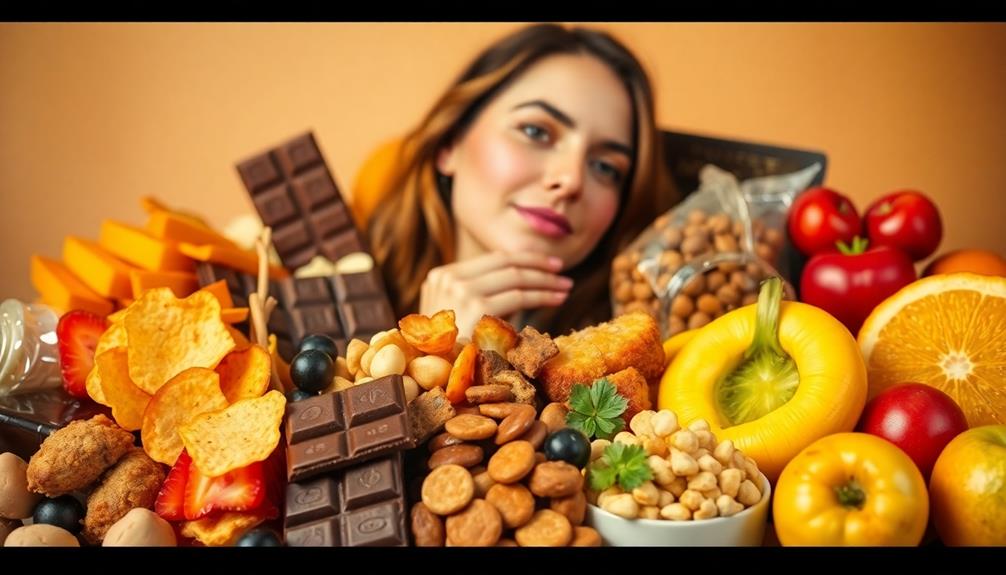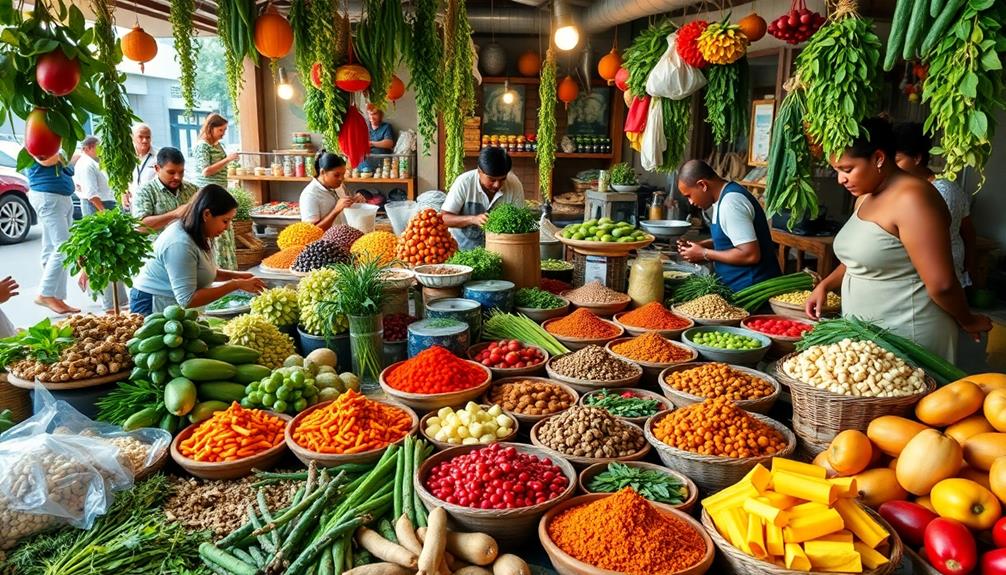During your menstrual cycle, hormonal changes stir intense food cravings. As estrogen drops and progesterone rises, your appetite regulation gets disrupted. You might find yourself craving high-carb and sweet foods, especially chocolate, due to increased insulin resistance and falling serotonin levels. These cravings often peak 7 to 10 days before your period starts, and emotional factors play a significant role. About 70% of women report these cravings during PMS, linking them to comfort and cultural influences. Understanding what's happening can help you manage these cravings effectively. Stay tuned to uncover more insights into this fascinating topic.
Key Takeaways
- Hormonal fluctuations, particularly a drop in estrogen and a rise in progesterone, significantly impact appetite regulation, leading to increased cravings during menstruation.
- Cravings typically intensify 7 to 10 days before menstruation, peaking alongside PMS symptoms in about 70% of women.
- Psychological factors, including emotional distress and societal norms, often drive cravings for sweet foods, especially chocolate, during the menstrual cycle.
- Nutritional strategies like consuming high-fiber foods, omega-3 fatty acids, and calcium-rich options can help stabilize hormones and alleviate cravings.
- Avoiding processed and high-sugar foods can minimize mood swings and discomfort associated with menstrual cravings.
Hormonal Changes and Cravings
During the luteal phase of your menstrual cycle, hormonal changes can trigger intense food cravings. As estrogen levels drop and progesterone rises, your body's appetite regulation gets thrown off balance. This fluctuation often leads to cravings for high-carb and sweet foods, as you may find yourself yearning for items like chocolate or pastries.
Notably, many women may also gravitate towards comfort foods such as Mushroom Masala or rich desserts like Rasgulla during this time to satisfy their cravings.
Research shows that serotonin levels decrease before menstruation, which plays a significant role in these cravings. Your body naturally seeks to boost serotonin production through food intake, making you more inclined to reach for carbohydrates.
Additionally, during this phase, increased insulin resistance can heighten your cravings, changing your body's metabolic response to food.
Emotional factors also come into play, as mood swings linked to hormonal changes can exacerbate your cravings. This emotional rollercoaster might lead to impulsive eating behaviors, pushing you toward comfort foods that provide a temporary sense of relief.
Understanding these hormonal changes and their impact on your cravings can empower you to make more mindful choices during this challenging time in your menstrual cycle.
Timing of Menstrual Cravings
You might notice your cravings kick in about 7 to 10 days before your period starts, aligning with other PMS symptoms.
During this time, many women find themselves reaching for comforting foods, similar to how holiday favorites like Turkey Soup can provide warmth and satisfaction.
This timing is largely influenced by hormonal fluctuations, especially the rise in progesterone and drop in estrogen.
Understanding this phase can help you prepare for those intense cravings that often hit right before menstruation.
Hormonal Fluctuations Timing
Cravings often hit hard 7 to 10 days before your period, a time when hormonal fluctuations are at play. During this luteal phase, progesterone levels rise, and you might start craving comfort foods. As estrogen levels drop just before menstruation, you may notice an increase in cravings for carbohydrates and sweets. This is linked to serotonin, which can decline during this time, pushing you toward high-calorie foods that temporarily lift your mood.
Here's a quick look at how your cravings can change:
| Days Before Period | Hormonal Changes | Craving Type | Serotonin Level | Emotional Impact |
|---|---|---|---|---|
| 10-7 | Rising progesterone | Moderate cravings | Stable | Slightly elevated |
| 6-4 | Estrogen decline begins | Increased cravings | Dropping | Heightened emotions |
| 3 | Peak cravings | Sweet and carb-heavy | Low | Compulsive eating |
| 2 | Hormones at their lowest | Intense cravings | Very low | Increased distress |
| 1 | PMS symptoms peak | High comfort food | Lowest | Emotional turmoil |
Recognizing these patterns can help you manage your cravings more effectively during your menstrual cycle.
PMS Symptom Onset
As the luteal phase progresses and PMS symptoms set in, cravings often intensify. You might notice that about 7 to 10 days before your period, those food cravings kick in more strongly. This aligns with hormonal fluctuations: estrogen levels drop while progesterone rises, creating a perfect storm for cravings.
Studies show that around 70% of women experience food cravings during PMS, with common desires for high-carb and sweet foods, like chocolate and pastries. This can be likened to the comforting nature of traditional Italian dishes, such as Agnolotti, which often provide a satisfying blend of flavors and textures that many crave during this time.
These cravings aren't just random; they're linked to serotonin deficiency. When your serotonin levels dip, your body craves carbohydrates and sugars as a quick way to boost your mood.
This response makes sense, considering the emotional distress many feel during PMS. As you indulge in comfort foods, the starchy options can release serotonin, temporarily lifting your mood and alleviating some PMS symptoms.
Cravings Pre-Menstruation Phase
In the week leading up to menstruation, many women find themselves grappling with intense food cravings. These cravings typically emerge during the luteal phase of the menstrual cycle, about 7 to 10 days before your period starts. As your menstrual cycle hormones fluctuate, you might notice a drop in estrogen and a rise in progesterone, which greatly influences your desire for high-carb and sweet foods.
During this time, some may crave comfort foods, similar to how one might enjoy a dish like Red-Braised Pork Belly, which offers rich flavors and satisfying textures. Research shows that nearly 70% of women experience food cravings tied to premenstrual syndrome (PMS) symptoms, with cravings for chocolate and other sweets being particularly common.
The emotional factors at play, such as mood swings and irritability, can exacerbate these cravings and lead to impulsive food choices.
Interestingly, when you indulge in carbohydrate-rich foods, your body releases serotonin, a neurotransmitter that can temporarily alleviate emotional distress associated with PMS. This connection reinforces your desire for those comforting treats during this time.
Understanding these cravings can help you manage them more effectively, allowing you to make mindful choices while maneuvering the ups and downs of your pre-menstrual phase.
Emotional Factors Influencing Cravings
During your menstrual cycle, hormonal mood swings can trigger intense cravings, making you reach for comfort foods.
These cravings may lead you to seek out rich, flavorful dishes, similar to the comforting warmth of a traditional Brazilian stew like Caldeirada.
You might find yourself drawn to sweet or starchy snacks, thanks to the psychological associations you have with these foods.
Understanding these emotional factors can help you navigate your cravings more effectively.
Hormonal Mood Swings
Hormonal shifts play an essential role in influencing emotional well-being and food cravings throughout the menstrual cycle. During the luteal phase, you experience significant hormonal fluctuations, particularly a rise in progesterone levels and a drop in estrogen.
These changes can trigger mood swings, making you feel more anxious or irritable, which in turn heightens cravings for high-carb and sweet foods. Many women find comfort in indulging in festive snacks, such as Graveyard Taco Dip, which may provide a sense of joy during this time.
Around 70% of women notice that their cravings are linked to these emotional changes, peaking about four days before menstruation. You might find yourself reaching for sweet treats or high-calorie snacks as a way to boost serotonin levels and temporarily lift your mood.
In fact, studies show that nearly 49% of women report a stronger desire for sweet foods during this phase, directly correlating with those mood swings and emotional eating tendencies.
To combat these cravings and emotional symptoms, consider trying cognitive behavioral therapy or mindfulness techniques. They can help you manage your emotional state and improve your overall quality of life during this challenging time, making it easier to navigate those cravings without giving in impulsively.
Psychological Food Associations
Food cravings often stem from deep-seated psychological associations that can intensify during the luteal phase of your menstrual cycle. Emotional factors, like mood swings and irritability, play a significant role in these cravings.
For instance, nearly 49% of women report a heightened desire for sweet foods during this time, with chocolate being a prime example. You might associate chocolate with comfort, stemming from cultural influences that suggest it's a go-to treat for many women.
Similarly, traditional Indonesian desserts like Kue Putu and Dadar Gulung are often enjoyed during festive occasions, creating strong positive associations with sweetness and comfort.
These psychological associations amplify your cravings, especially if past experiences linked these foods to feelings of reward or happiness. The emotional response you have when indulging in sweet treats can create positive expectations, leading to habitual cravings.
However, indulging often brings feelings of guilt, particularly with high-calorie, carbohydrate-rich foods, which can spiral into a cycle of cravings and regret.
To better manage these cravings, consider employing cognitive behavioral therapy and mindfulness techniques. These strategies can help you address emotional factors effectively, allowing you to break the cycle of cravings and find healthier ways to cope during your menstrual cycle.
Common Food Cravings
Many women frequently experience strong cravings for specific foods in the lead-up to their menstrual cycle. These cravings can feel almost impossible to resist, especially during PMS.
Research shows that about 70% of women face food cravings tied to their menstrual cycle, with a notable spike in the luteal phase. This time can also evoke memories of comforting dishes from various culinary traditions, making cravings even more intense.
- The irresistible pull of chocolate
- The comforting allure of pastries
- The savory satisfaction of fried snacks
You might find yourself reaching for high-calorie, carbohydrate-rich options as your serotonin levels dip just before your period. In fact, nearly half of women report that they crave sweets during this time.
This isn't just about hunger; it's about emotional comfort. Cultural influences also play a role, as U.S. women are twice as likely to crave chocolate compared to men, highlighting the powerful psychological connections we've with certain foods.
Understanding these cravings can help you navigate your relationship with food during this time. So, when those cravings hit, remember that it's a natural response to hormonal changes, and you're not alone in this experience.
Nutritional Needs During Menstruation
During your menstrual cycle, your body has unique nutritional needs that can help you feel better and manage cravings. Hormonal fluctuations, particularly the drop in estrogen and serotonin, often lead to increased cravings for carbohydrates and sweets.
To navigate these cravings effectively, consider implementing specific nutritional strategies. Incorporating high-fiber foods, omega-3 fatty acids, and iron-rich options into your diet can alleviate menstrual symptoms and stabilize hormonal levels. For instance, enjoying an Heirloom Bean Stew can provide protein and fiber to help keep you satisfied.
Calcium-rich foods are also beneficial, as they can reduce PMS symptoms while supporting your mood. Staying hydrated is essential too; it helps manage cravings and prevents overeating during this phase.
Listening to your body's cravings is key; they might signal a need for increased calories. Opt for healthier alternatives to satisfy these cravings without excessive calorie intake.
Engaging in regular physical activity complements your nutritional choices, as exercise can further mitigate menstrual symptoms and enhance your overall well-being.
Foods That Alleviate Symptoms
Incorporating specific foods into your diet can markedly alleviate menstrual symptoms and enhance your overall comfort. By focusing on the right nutrients, you can tackle cravings and mitigate discomfort during menstruation. Here are some foods that can help:
- Leafy Greens: Spinach and kale are loaded with iron and magnesium, which can ease bloating and cramping, much like the way traditional dishes like Ugali and Sukuma Wiki provide essential nutrients for overall health.
- Whole Grains: Oatmeal and brown rice provide complex carbohydrates, stabilizing your blood sugar levels and reducing those sugary cravings.
- Lean Proteins: Chicken and legumes support muscle health, keeping your energy up and fighting fatigue.
Hydration's vital too. Drinking plenty of water and munching on hydrating foods like cucumbers and watermelon can help diminish bloating.
And if you're craving chocolate, reach for dark chocolate in moderation—it not only satisfies your sweet tooth but also delivers magnesium, potentially relieving cramps and lifting your mood.
Foods to Avoid
When you're menstruating, it's smart to steer clear of certain foods that can worsen your symptoms.
Reducing sugar, caffeine, and salty snacks can help stabilize your mood and minimize discomfort.
Additionally, cutting back on dairy and processed foods may reduce bloating and inflammation, making your cycle a little easier to manage.
Sugar and Processed Foods
Avoiding sugar and processed foods can make a significant difference in how you feel during your menstrual cycle. High sugar intake can lead to spikes in blood glucose, causing intense cravings that crash and worsen mood swings.
When you're already battling irritability, the last thing you need is to fuel those feelings with sugary snacks. Similarly, processed foods, packed with preservatives and unhealthy fats, can lead to bloating and inflammation, adding to your discomfort.
Consider these emotional triggers when you reach for those snacks:
- Disappointment: When cravings derail your efforts to feel better.
- Frustration: As you battle mood swings while craving unhealthy options.
- Regret: After indulging in foods that make you feel worse.
Caffeine and Salty Snacks
As you navigate through your menstrual cycle, it's crucial to be mindful of your caffeine and salty snack intake. Caffeine can worsen anxiety and discomfort during menstruation, leading to heightened irritability and mood swings. These factors may amplify your cravings, making it harder to resist unhealthy choices.
During the luteal phase, limiting caffeine is particularly important, as it can interfere with serotonin levels, which are already impacted by hormonal fluctuations.
Salty snacks, especially processed ones, can exacerbate your menstrual symptoms. High sodium intake can cause water retention and bloating, making you feel even more uncomfortable.
As a result, the desire for more salty foods can increase, further complicating your experience. By reducing your consumption of salty snacks, you can alleviate excess water retention and promote a more comfortable menstrual cycle.
Focusing on hydration and healthier snack alternatives can help balance your cravings and support your overall well-being.
Dairy and High-Fat Foods
Your dietary choices during menstruation can greatly impact how you feel, especially when it comes to dairy and high-fat foods. Many people find that dairy products can exacerbate bloating and discomfort during this time, making it wise to limit your intake.
High-fat foods can lead to increased inflammation, worsening menstrual cramps and contributing to those pesky PMS symptoms.
Consider these emotional impacts of indulging in dairy and high-fat foods during your period:
- Bloating: Feeling uncomfortable and heavy can overshadow your day.
- Mood Swings: High-fat snacks might spike your energy temporarily, but they can crash your mood just as fast.
- Cravings: Processed high-fat foods often contain added sugars, leading to uncontrollable cravings that can derail your diet.
Instead of reaching for those tempting treats, focus on healthier fat sources to help maintain your mood and energy levels.
Monitoring and reducing your consumption of dairy and high-fat foods can promote better overall well-being and potentially alleviate some PMS symptoms.
Your body will thank you for making these mindful choices.
Psychological Impact of Cravings
Experiencing heightened food cravings during menstruation can considerably impact your psychological well-being. Emotional symptoms like anxiety and depression often intensify these psychological cravings, leading you into a cycle of emotional eating. You might find yourself reaching for comfort foods to alleviate negative emotions, only to feel guilt afterward for indulging. It's a frustrating pattern that many women face.
During the luteal phase of your menstrual cycle, studies show that nearly 49% of women report a stronger desire for sweet foods. This impulsivity can drive you to seek high-calorie treats, especially when irritability creeps in.
You're not alone; cultural influences also play a role. In the U.S., women are twice as likely to crave chocolate compared to men, which highlights how societal norms shape your cravings.
Moreover, consuming sweet foods can trigger positive emotional responses, reinforcing habitual cravings. This link between your dietary choices and psychological state becomes even more pronounced during menstruation, as your cravings become intertwined with your emotional health.
Understanding this impact can help you navigate the complexities of cravings and their effects on your overall well-being.
Managing Cravings Effectively
Effectively managing cravings during menstruation can make a significant difference in your overall well-being. Understanding your body's signals is key. Cravings often arise due to hormonal shifts that influence serotonin levels, so it's crucial to stabilize your food intake. Incorporating complex carbohydrates like whole grains and legumes can help keep your blood sugar steady, reducing those pesky cravings.
Here are some strategies to help you manage cravings effectively:
- Stay hydrated to combat bloating and curb unnecessary cravings.
- Engage in regular physical activity; aim for 30 minutes, 4-6 times a week to naturally boost your mood.
- Practice mindful eating—plan meals and keep healthy snacks accessible to avoid emotional eating.
Recognizing cravings as signals can empower you to make better dietary choices during your menstrual cycle. By focusing on portion control, you can enjoy high-calorie foods without overindulging.
These practices not only support a balanced diet but also promote overall wellness, making your menstrual cycle feel a little more manageable. Remember, you're in control of your cravings, and with the right strategies, you can navigate this time with confidence.
Future Research Directions
Understanding how to manage cravings during menstruation opens the door to exploring future research directions. To better understand food cravings linked to the menstrual cycle, future research should focus on larger-scale studies that validate current findings.
Investigating how conditions like polycystic ovary syndrome influence insulin resistance and cravings could provide valuable insights. Additionally, examining the relationship between different phases of the menstrual cycle and specific food preferences can shed light on the biological and psychological factors driving cravings.
Employing diverse methodologies, including longitudinal designs, will help assess how hormonal fluctuations impact dietary choices over time.
Exploring the neurobiological mechanisms behind cravings is another promising avenue. Understanding how reward pathways in the brain activate during the menstrual cycle could deepen our comprehension of eating behaviors.
Moreover, research should evaluate the efficacy of various dietary interventions, such as seed cycling or omega-3 supplementation, to determine their role in managing cravings and enhancing overall menstrual health.
Frequently Asked Questions
What Is the Science Behind Period Cravings?
You often experience cravings due to hormonal changes in your body. These fluctuations affect your mood and metabolism, making you seek comfort foods, especially sweets and carbs, as your body tries to regulate itself.
What Does It Mean When You Crave Food on Your Period?
When you crave food on your period, it often signals your body's need for comfort or energy. These cravings can reflect hormonal changes, emotional states, or nutritional needs, urging you to listen to what your body wants.
Why Do I Want to Eat so Much During My Period?
You might want to eat more during your period due to hormonal changes affecting your mood and energy levels. Your body craves comfort and quick energy, leading you to seek out those satisfying, calorie-dense foods.
Are Period Cravings Similar to Pregnancy Cravings?
Period cravings and pregnancy cravings differ considerably. You might crave sweet and high-carb foods during your period, while pregnancy cravings can lead you to seek out strange combinations. Hormonal changes influence both, but their nature varies.
Conclusion
As your body dances through the hormonal waves of menstruation, cravings can feel like a siren's call, drawing you toward comfort foods. You're not alone in this journey; many share your struggles and triumphs. Embracing these cravings with mindfulness can transform them from a burden into a moment of self-care. By understanding their roots, you can nourish both your body and soul, emerging stronger and more attuned to your needs—ready to face the world with renewed vigor.








